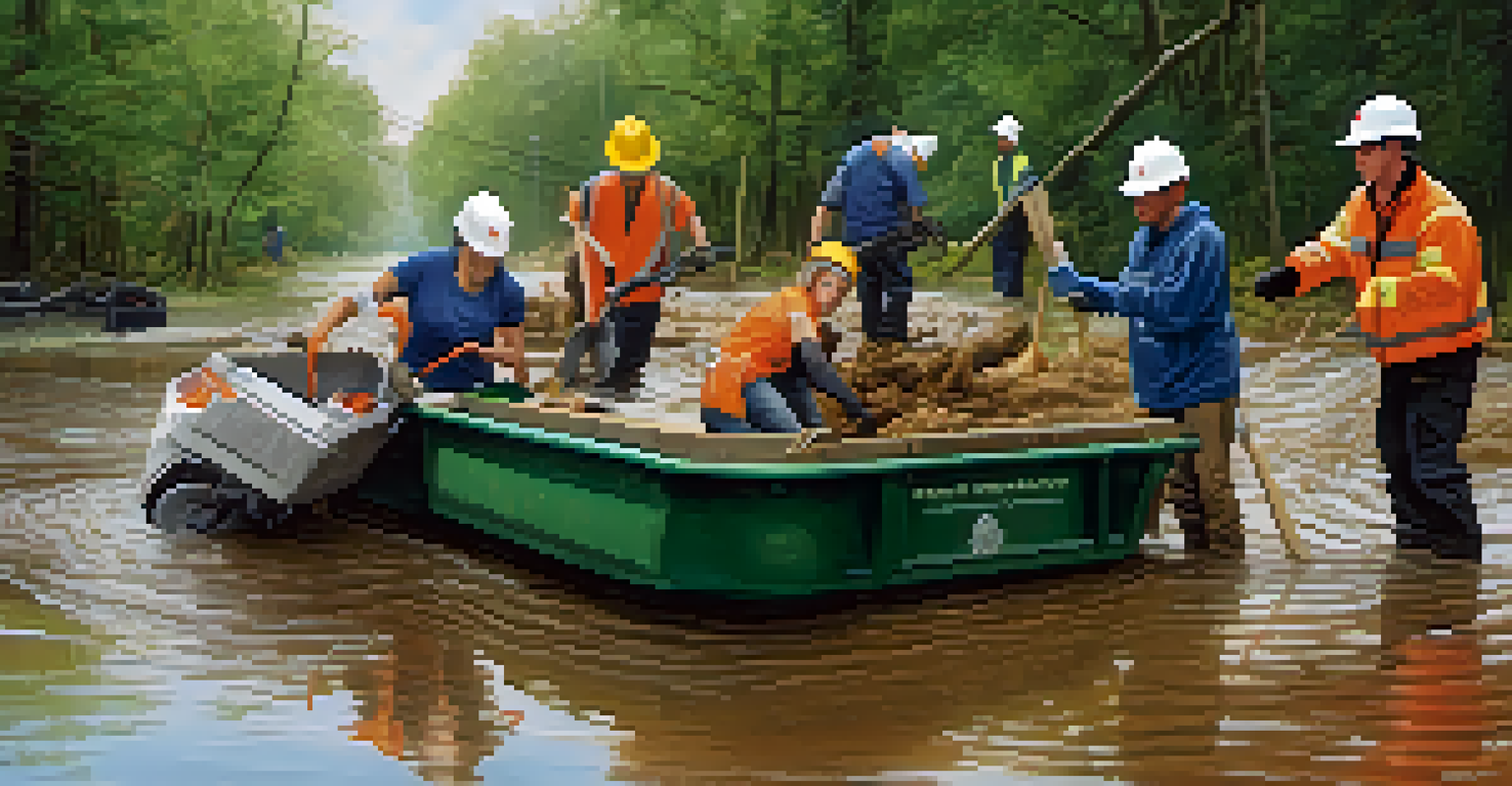Community Resilience Initiatives in Colorado After Disasters

Understanding Community Resilience in Colorado
Community resilience refers to the ability of a community to bounce back from disasters. In Colorado, this resilience is vital due to the state's unique challenges, such as wildfires and floods. By fostering strong social networks and preparedness, communities can better face these adversities.
Resilience is not just about recovery, it's about learning and adapting.
In essence, resilience is about more than just recovery; it's about learning and adapting. For instance, when a community experiences a wildfire, they don't just rebuild; they implement new strategies to reduce future risks. This proactive mindset is crucial in minimizing the impact of future disasters.
Engaged citizens play a key role in resilience. Their participation in planning and response initiatives helps create a culture of preparedness, ensuring that everyone knows their role in times of crisis. In Colorado, local organizations often lead these efforts, bringing people together to share knowledge and resources.
Key Initiatives Supporting Resilience Efforts
Several initiatives in Colorado focus on enhancing community resilience post-disaster. Programs like the Colorado Resilience Framework provide guidelines and resources for communities to assess their vulnerabilities and strengths. These frameworks empower local leaders to create tailored action plans.

Another significant initiative is the 'Ready, Set, Go!' program, which educates residents on how to prepare for wildfires. This program helps individuals understand evacuation routes, create emergency plans, and maintain defensible space around their homes. By being better prepared, the community as a whole becomes more resilient.
Community Resilience is Essential
In Colorado, community resilience is vital for effectively bouncing back from disasters like wildfires and floods.
Moreover, community-led projects often receive funding from state and federal grants aimed at disaster recovery. These funds support infrastructure improvements, like better drainage systems, which significantly reduce flooding risks. The collaboration between government and local entities is essential to building a robust resilience strategy.
The Role of Local Governments in Resilience Building
Local governments in Colorado play a vital role in fostering community resilience. They are responsible for emergency management, which includes planning for disasters and coordinating responses. This leadership is crucial in ensuring that communities are well-prepared when disaster strikes.
In the face of disaster, community collaboration can make all the difference.
Moreover, local officials actively engage residents in resilience planning. By holding workshops and community meetings, they gather input and create a sense of ownership among citizens. This involvement not only educates the public but also strengthens the bonds within the community.
Additionally, local governments often partner with organizations and agencies to implement resilience programs. Collaborations with nonprofits and state agencies can amplify resources and expertise, making initiatives more effective. Together, they can address specific needs and vulnerabilities unique to their communities.
Grassroots Efforts: Community-Led Responses
Grassroots efforts are essential in building resilience at the community level. Local volunteers often step up to assist in recovery efforts, whether it's organizing clean-up crews or providing emotional support. These spontaneous acts of solidarity can make a significant difference after a disaster.
For example, after the devastating floods in 2013, many community members formed groups to help each other rebuild homes. This not only expedited the recovery process but also strengthened social ties. Such grassroots movements are a testament to the power of community collaboration in times of need.
Grassroots Efforts Drive Recovery
Local volunteers and grassroots initiatives play a crucial role in strengthening community ties and aiding recovery after disasters.
Furthermore, grassroots initiatives often lead to the creation of formal organizations dedicated to disaster preparedness. These groups can advocate for resources, provide training, and share knowledge on best practices. Their evolution from informal gatherings to structured organizations showcases the importance of community-driven resilience.
Education and Training as Resilience Tools
Education plays a pivotal role in enhancing community resilience. Programs aimed at teaching residents about disaster preparedness can empower individuals to take proactive steps. Simple actions, like creating emergency kits or developing communication plans, can have a profound impact.
Training sessions for community leaders and volunteers are equally important. These programs equip them with the skills to respond effectively during emergencies. For instance, first aid training, crisis communication, and resource management can make a significant difference when time is of the essence.
Moreover, schools and educational institutions in Colorado are increasingly incorporating resilience training into their curricula. By teaching children about emergencies and preparedness, future generations will be better equipped to handle disasters. This long-term approach ensures that resilience becomes a community norm.
Utilizing Technology for Enhanced Resilience
In today's digital age, technology plays a crucial role in community resilience. Tools like social media and emergency apps facilitate real-time communication during disasters. They enable communities to share information quickly, which can be lifesaving in critical situations.
For example, platforms that provide alerts about impending disasters can help residents prepare in advance. Apps that offer resources for emergency kits or evacuation routes can also guide families in making informed decisions. Technology makes information more accessible, ultimately enhancing preparedness.
Education Enhances Preparedness
Education and training programs empower residents with the knowledge and skills needed for effective disaster preparedness and response.
Additionally, data analytics is being used to assess vulnerabilities and plan for future disasters. Local governments can analyze historical data to identify patterns and prioritize resources effectively. This tech-driven approach ensures that communities are not just reacting to disasters but are strategically preparing for them.
Success Stories: Colorado Communities in Action
Several Colorado communities exemplify resilience through their proactive initiatives. For instance, the town of Estes Park has implemented a comprehensive wildfire mitigation plan that includes controlled burns and community education. Their efforts have significantly reduced the risk of devastating fires.
Similarly, Boulder has focused on flood resilience by investing in green infrastructure solutions, such as rain gardens and permeable pavements. These projects not only manage stormwater effectively but also enhance the community's aesthetic appeal. Boulder’s approach showcases the intersection of environmental stewardship and disaster preparedness.

These success stories are not just about recovery; they serve as inspiration for other communities. They illustrate that with commitment and collaboration, significant strides can be made in resilience efforts. By sharing these experiences, Colorado communities foster a culture of learning and adaptability.